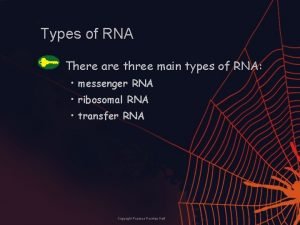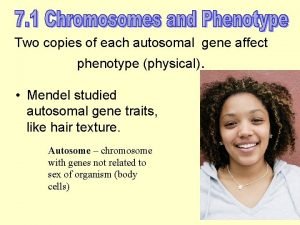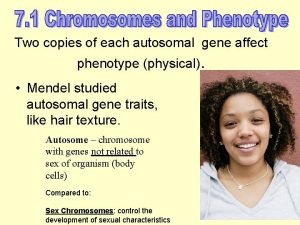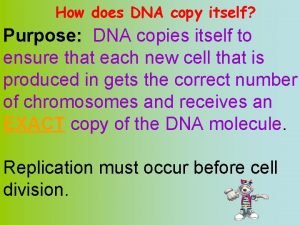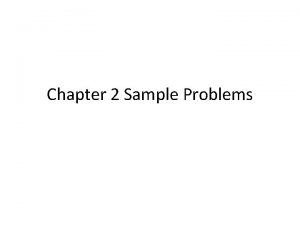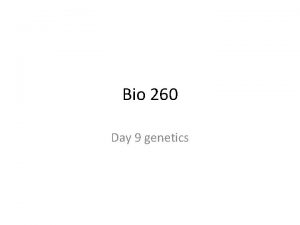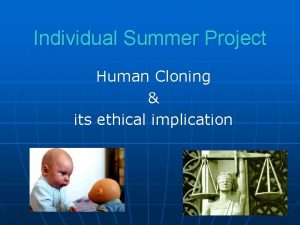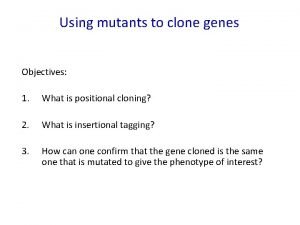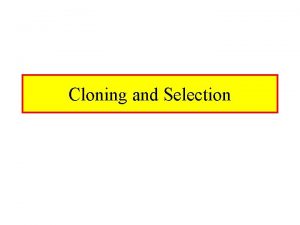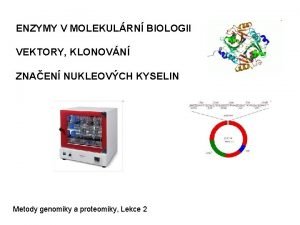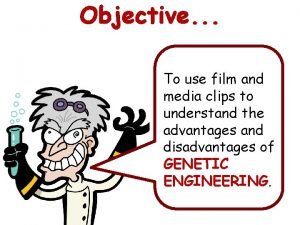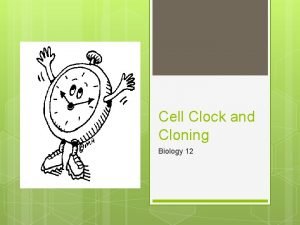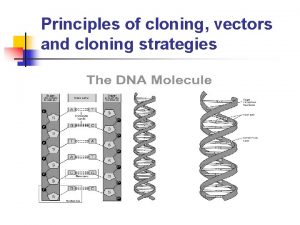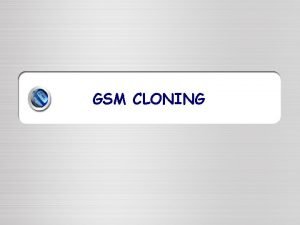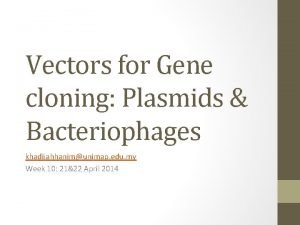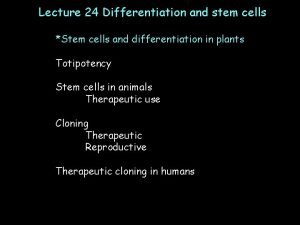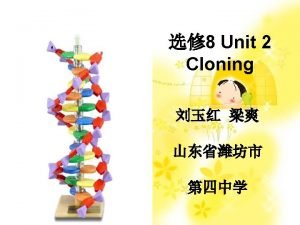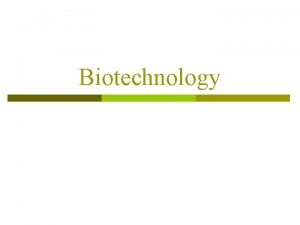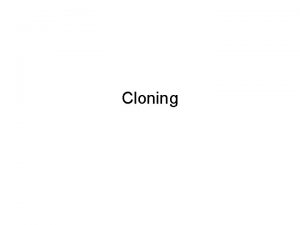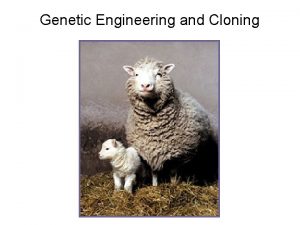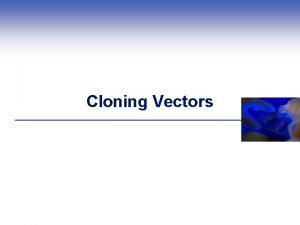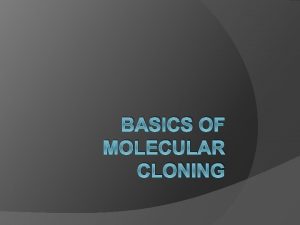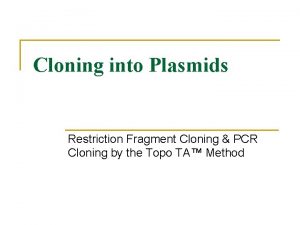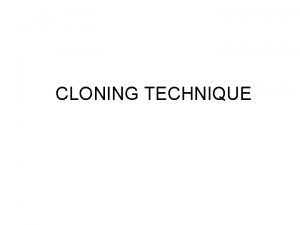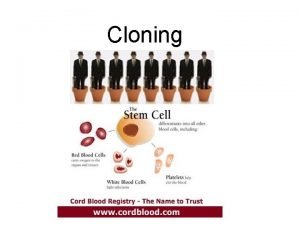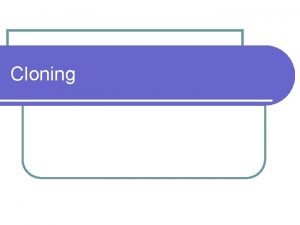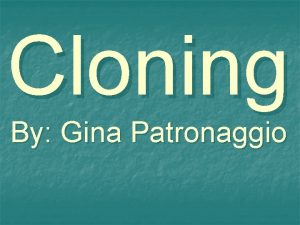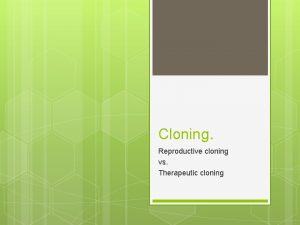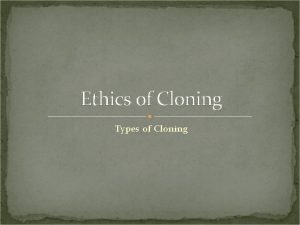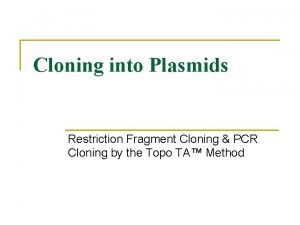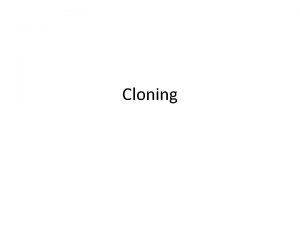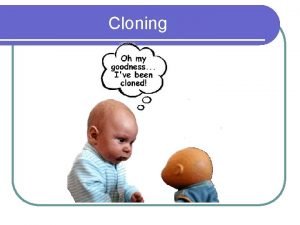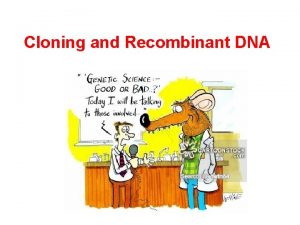CLONING Cloning Production of many identical copies of



























- Slides: 27

CLONING

Cloning � Production of many identical copies of a molecule or population of genetically identical individual. � Clone � 4 – “trunk or branch” types ◦ Gene cloning ◦ Reproductive cloning ◦ Embryo cloning/ Therapeutic cloning ◦ Tissue cloning

Gene cloning � Also called DNA cloning or recombinant DNA technology � Widely used in genetic engineering for sequencing genome and gene therapy.

Recombinant DNA technology

Recombinant DNA technology � It is the ability to introduce genetic material into cells in such a way as to enable that DNA to replicate and be passed on to the progeny of cells. � It is also known by terms like genetic engineering, gene cloning, molecular cloning or gene manipulations. � In 1973, Boyer & Cohen introduced the desired genes of one organisms into another and cloned new genes.

Steps Involved � Step 1 Generation of DNA fragments and selection of desired segment of DNA – Restriction endonucleases. � Step 2 Selection of vectors/cloning vectors. � Step 3 Insertion of the selected DNA into cloning vector – DNA ligase.

� Step 4 Introduction of recombinant DNA into host cells. � Step 5 Propagation of recombinant DNA in the host cell. � Step 6 Selection of clones with recombinant molecules. � Step 7 Expression of the cloned gene in the host cell to produce our protein of interest.


Uses Of Recombinant DNA technology � Role of recombinant DNA technology in medicine. Diagnostic i. Diagnosis of infectious diseases – TB, AIDS, Malaria, chagas disease, etc. ii. Diagnosis of genetic diseases iii. Diagnosis of Alzheimer's disease §

Therapeutic Ø Gene therapy Process of inserting certain genes into the cell to treat diseases. § Disease Gene therapy Sickle cell anemia Beta globin Cystic fibrosis CFTR SCID Adenosine deaminase Hemophilia Factor IX Duchenne dystrophy Dystrophin

§ Role of recombinant DNA technology in pharmaceutical products � Human protein replacements � Vaccines � Therapeutic agents

Reproductive cloning � Used to produce an animal having same nuclear DNA from existing animal. � Uses somatic cell transfer principle. � In 1950 this was first carried out in frogs. � In 1997 Ian Wilmut -Dolly the sheep from nucleus of mammary epithelial cells that was transplanted into unfertilized egg. � Has been used to create variety of mammalians species. � 1 -3% success rate.

Cloning Dolly 1997 - 2003 (Roslin Institute http: //www. roslin. ac. uk/library/)






The Important Facts About Human Cloning 1. A clone would be a baby just like any other baby. 2. There is no important difference between a clone and an identical twin.

Embryo cloning � Also called therapeutic cloning. � Used to create stem cells to study evolution and disease treatments. � Stem cells are used to replace degenerating cells in Alzheimer's disease, cancer. � Transplanted cells are genetically identical to recipientbypasses immune system rejection.



Tissue cloning � Also called tissue culture. � Clone tissues used to study action of hormones, antibiotics and pharmaceutical products.

Ethical issue � Cloning of humans � Destruction of embryonic cells from which stem cells are produced. � Alleviated by –reprogramming somatic cells into pleuripotent state resembling embryonic stem cells

Potential uses of cloning � Replacing organs and other tissues Infertility � Replacing a lost child � Cloned animal for consumption � Gene therapy � Saving endangered species � Genome library �

DRAWBACKS Low success rate (Dolly took 276 attempts) � Tumours � Genetic defects � Over-growth syndrome � Pre-mature ageing (genetic age) � Massive quantities of human eggs required � Reduction in adaptability – genetic uniformity � Lack of knowledge

THANKYOU
 Identical by descent vs identical by state
Identical by descent vs identical by state Sebutkan alur produksi multimedia
Sebutkan alur produksi multimedia What are the three main types of rna
What are the three main types of rna Difference between autosomes and sex chromosome
Difference between autosomes and sex chromosome Annotations sur les copies
Annotations sur les copies Two copies of each autosomal gene affect phenotype
Two copies of each autosomal gene affect phenotype How does dna copy itself
How does dna copy itself Pixel copies recorded a cash collection
Pixel copies recorded a cash collection Pcr copies
Pcr copies Cned.espace inscrit
Cned.espace inscrit Copies of dna
Copies of dna Identity cloning and concealment
Identity cloning and concealment Logan stancato
Logan stancato Clonaid
Clonaid Map based cloning
Map based cloning Suspension cloning
Suspension cloning Nick translation
Nick translation Cloning vector
Cloning vector Advantages of cloning
Advantages of cloning Cloning in nature
Cloning in nature Cosmid vector slideshare
Cosmid vector slideshare Gsm cloning
Gsm cloning Clock gate cloning
Clock gate cloning Function of plasmid
Function of plasmid Therpeutic cloning
Therpeutic cloning Cloning dangers
Cloning dangers Advantages of cloning
Advantages of cloning Cloning and sequencing explorer series
Cloning and sequencing explorer series


